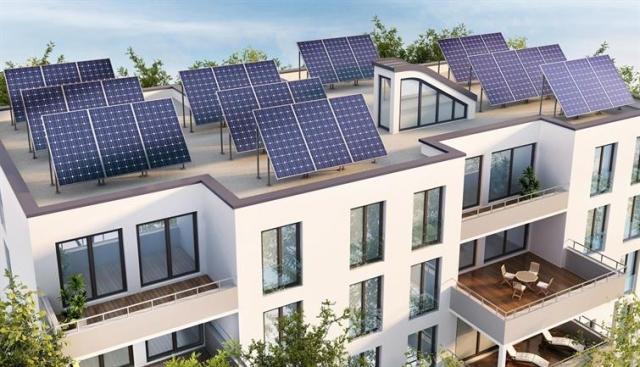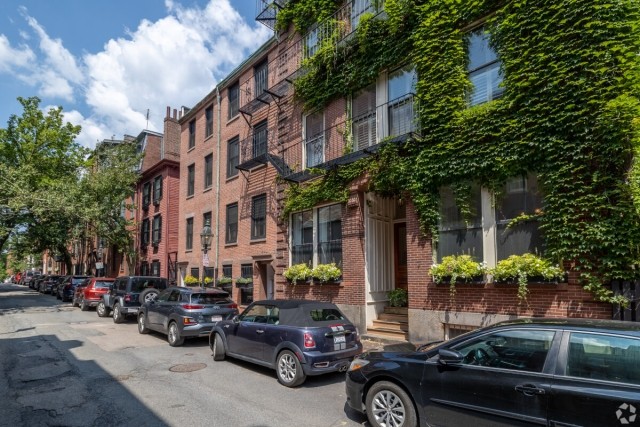Reducing your carbon footprint and being environmentally conscious are noble endeavors, but did you know that choosing a green apartment building could reduce your overall living costs? You can save the environment and put more money in your pocket. Talk about a win-win! In fact, depending on the features included in your apartment, you could save up to 20 percent on energy costs and up to 30 percent on water bills.
So how do you find a green apartment building? One easy way is to look for buildings with LEED certification. But what, exactly, is LEED certification? Let’s take a closer look at what LEED means, the green building trends you might see in some apartment buildings, and how they can help save you money.
What Does LEED-Certified Mean?
LEED stands for Leadership in Energy and Environmental Design. A LEED certification is recognized worldwide. It is the standard for rating green buildings of all types. Apartment buildings that are LEED-certified are considered healthy due to the improved air quality, cost-saving, and highly efficient, and on average their vacancy rates are roughly four percent lower than properties that aren’t LEED-certified.
The number of LEED-certified buildings in the US has been steadily on the rise, up from about 3,100 buildings in 2005 to just over 69,000 in 2019. The reason for the upward trend is simple. According to a report by CoStar, owners of LEED-certified buildings save about 15 percent on energy expenses, and the modifications cost little to make. Just simple changes, such as switching to LED lighting or making small adjustments to heating and cooling systems, result in huge savings. Additionally, according to the American Council for an Energy-Efficient Economy, apartment communities that implement these types of upgrades can improve the property’s energy efficiency up to 30 percent.
So, how does LEED certification work? Basically, buildings apply for certification. The buildings can earn points, up to 136 total, in a variety of categories depending on the green strategies they’ve used. Based on the number of points they earn they will be awarded certification at certain levels:
- Certified – the building earned 40-49 points
- Silver – the building earned 50-59 points
- Gold – the building earned 60-79 points
- Platinum – the building earned 80 or more points
The buildings are judged on different measures and a variety of requirements. Here’s a breakdown of the categories:
1. Energy and Atmosphere
This category includes things like insulation, heating and cooling, and renewable energy generation.
2. Sustainable Sites
This category considers green initiatives taken during the actual building process.
3. Indoor Environmental Quality
For this category, the building must show how pollutants are eliminated or controlled in living spaces.
4. Materials and Resources
To score well in this category, buildings must choose sustainable building materials, reduce waste, and reuse and recycle materials.
5. Innovation and Design
This category awards points based on the number of new, innovative features used in the building.
6. Water Efficiency
This category is all about the toilets. Simply, they shouldn’t consume more than 1.6 gallons of water per flush.
7. Integrative Process
This category focuses on the pre-design phase, specifically how they relate to energy and water-related systems.
8. Location and Transportation
Properties looking to earn points in this category need to show community connectivity, especially as it relates to transportation.
9. Regional Priority
Points are awarded in this category to buildings that address geographically specific priorities, especially those relating to the local environment, social equity, and public health.
10. Awareness and Education
To score points in this category, the property needs to make sure residents know how to use their energy-efficient appliances and other green features.
Of course, an apartment building can have green features without being LEED certified. If you’re curious about what green initiatives your apartment community has undertaken, ask your property manager.
Green Building Trends
While the most common green features include LED lighting, energy-efficient appliances, and low-flow showerheads, many LEED-certified apartment buildings have started including large windows to maximize natural light and water-efficient landscaping that consists of native and drought-tolerant plants.
Here are more green building trends you might encounter:
- Reflective roofing material that lowers the inside temperature of the building and reduces the need for air conditioning
- Solar paneling
- Buildings that use recycled materials and low-VOC paint and carpet
- Apartments built near transit stops or bike paths
- Apartment communities with bike storage on the property
- Smart thermostats
- Green rooftops that limit rainwater runoff and lower cooling costs
- Electric car-charging stations
- Ventilation systems that improve indoor air quality by bringing in fresh air and sending out stale air
- On-site recycling centers and/or community gardens
- Natural insulation
- Natural flooring options like cork or bamboo
- Smoke-free buildings
How to Find a Green Apartment Building
While you’ll find green apartment buildings across the US, some states have been recognized for their green initiatives. In January 2020, the USGBC released a list of the Top 10 states for LEED green building, and Colorado came in at number one with the most green square footage per capita. Illinois, New York, Massachusetts, and Hawaii rounded out the top five.
If you are searching for an apartment in Boulder, considered one of the most eco-friendly cities in Colorado, it might be easier to find LEED-certified apartments and green features than you might in a city with fewer green buildings.
No matter where you are searching, finding a green apartment building on Apartments.com is easy. Simply type “LEED” as your keyword under “More Filters.” Apartments that have been certified will most likely state this in their property description, as well. You may even see their certification level (i.e., LEED Gold-Certified).
Under “Amenities,” look for things like Energy Star appliances, smart home features, solar panels/solar shades, bike storage, smoke-free, and electric car charging stations. Other terms you might see include walkable, near mass transit, near a bike trail, community garden, recycling center, or pedestrian friendly.
Ways to Save Money By Reducing Your Carbon Footprint
In the US, the average person has a carbon footprint of 16 tons. Elsewhere in the world, the average is closer to four tons. A carbon footprint is basically the amount of greenhouse gases, specifically carbon dioxide and methane, that is generated per person. These gases are emitted through everyday activities involving transportation, food, consumption, and household energy.
Even if you don’t live in a green building, you can still reduce your carbon footprint and save money. Here are some easy ways to do this:
Choose LED or CFL bulbs
According to the US Department of Energy, old-fashioned incandescent light bulbs use a lot of energy, and 90 percent of the energy is given off as heat. Those bulbs of yesteryear may light a sense of nostalgia, but they are literally burning through your money. CFL bulbs use less electricity and last up to 10 times longer. With its energy savings, one CFL bulb pays for itself in less than nine months and will continue to save you money each month. LED bulbs are slightly more expensive, but they have a very low energy use, often have features like daylight and motion sensors, and work well indoors and out.
Reduce water usage
Use your dishwasher. Contrary to popular belief, a dishwasher is more water-efficient than handwashing, especially if you have an Energy Star certified dishwasher. Washing dishes in the sink uses up to 27 gallons of water per load, where an Energy Star dishwasher uses only about three gallons per load. Even a conventional dishwasher is better than handwashing, using about five or six gallons of water per load. Allow the dishwasher to fill completely before running it to save even more water.
Cut down on your shower time or install a low-flow shower head and faucet aerators. Other ways to cut down on water usage include turning off the water when brushing your teeth or shaving, taking a bath instead of a shower, making sure your toilet isn’t running or leaking, and dealing with dipping faucets as soon as possible. You’ll notice a big difference in your water bill just by making a few of these adjustments.
Unplug appliances when not in use
Vampire energy loss, which is the energy your appliances waste when they aren’t in use but are still plugged in, accounts for roughly 10 percent of residential energy use in the US. While 10 percent may not sound like a lot, it adds up – to roughly $19 billion a year nationwide, according to the Natural Resources Defense Council. That’s about $165 per household!
Be a safe driver
When driving, don’t speed or accelerate unnecessarily. Just by slowing down 5 to 10 mph, you can save about $2.46 per gallon of gas. Choose to walk, take public transportation, or ride your bike whenever possible.
Weather-proof your home
Ask your landlord about adding weather stripping or caulking around windows and doors to stop air leakage. This will help save money on heating and cooling.
Reduce, reuse, and recycle
By reducing the amount of waste and reusing what you can, you’ll save energy, reduce greenhouse gas emissions, and save money. Buy second-hand when you can, look for products that use less packaging, and look for reusable items rather than disposable ones. Maintain and repair items so you don’t have to replace them as often.
Try to eat less beef and dairy
Livestock is responsible for almost 15 percent of the world’s greenhouse gases every year – more than vehicles, ships, and airplanes combined. Of that, beef production accounts for 41 percent. Meat is also expensive! Just having one meatless day could save you money, especially since plant-based dishes emphasize less expensive items like beans, grains, veggies, and fruit. Also, eat locally when you can. You’ll be surprised at how much you can save by shopping at the local farmers market, and you’ll be helping the environment. Food that isn’t transported over long distances means lower greenhouse gas emissions.
Get some houseplants
Not only do they make your apartment look nice, houseplants help purify the air and help fight off pollution. That’s great and all, but do they actually save you money? Yes! Because plants release oxygen and water vapor, the air in your apartment will be cooler, cutting down on the need for air conditioning in the summer. In the winter, that added humidity means you won’t need to run a humidifier. And with the health benefits from having cleaner air, you’re less likely to suffer from headaches and respiratory issues. If you have pets, be sure to choose plants that are non-toxic.
Use eco-friendly cleaning products
Help protect groundwater and the soil by using products that won’t harm the environment. For an even less expensive alternative, try using natural cleaning products like vinegar, lemon juice, and baking soda.
Ditch the plastic bottles
Switch to a reusable water bottle and you’ll save money and cut down on the amount of plastic that needs to be disposed of. Consider using a water filter or a pitcher with a filter if you don’t want to drink water straight from the tap.
Adjust your thermostat
Turn down your heat or air conditioning, especially during the times when you aren’t at home. Ask your landlord about installing a smart thermostat.
Try composting
Yes, it is possible to compost in an apartment! And you’ll have free fertilizer for those houseplants you’ve added to your space.
Rethink your energy provider
If you are able to choose your own power company, choose one that offers renewable energy options, which will lower your utility costs while reducing your carbon footprint.
Even if you don’t live in a green apartment building, you can still choose green options that will reduce your carbon footprint and save you money in the process. Look at you, saving green by going green!






